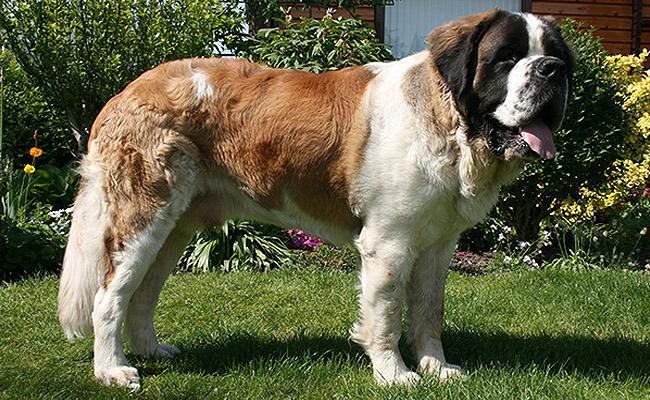Dog Pregnancy Calculator And Timeline
This giant dog breed was originally used to guard the grounds of Switzerland’s Hospice Saint Bernard and they helped to rescue lost travelers in the Swiss Alps. They were also used as farm dogs to protect cattle and for pulling a cart or wagon.
They got their name from the passes of Great and Little Bernard and before that, they were mostly referred to as “Saint Dogs”, “Noble Steeds”, etc.
This breed is very similar to the English Mastiff because they both share the same ancestor –the “AlpineMastiff”. Saint Bernard, in the past, was mostly lighter than the present large breed but they are very much alike in characteristics and strength.
Despite his size and muscular features, Saint Bernard proves to be a great family dog; they are friendly, gentle with children, and remain calm indoors. If you are planning to buy a Saint Bernard, then consider giving this article a quick glance.
Saint Bernard Breed Characteristics
- Origin: Switzerland
- Size: Giant
- Dog Breed Group: Working Group
- Purebred: Yes
- Lifespan: 8-10 Years
- Height: Male: 28-30 inches (71-76 cm), Female: 26-28 inches (66-71 cm)
- Weight: 140-180 pounds (64-82 kg), can go up to 260 pounds (118 kg) for larger males
- Coat Appearance: Dense, smooth or rough with a great deal of shedding
- Coat Colors: Red & white, brown & white, sometimes with black shading on the face and ears
- Temperament: Friendly, patient, extremely loyal, gentle
- Good With Children: Yes, very good with children due to their gentle nature
- Intelligence Level: High
- Good With Pets: Yes, generally good with other pets if properly socialized
- Hypoallergenic: No
- Grooming: Moderate to high, depending on coat type; requires regular brushing
- Barking: Moderate; not known for excessive barking
- Suitable For Apartments: No, their size and energy level are better suited for homes with more space
- Need For Exercise: Moderate; despite their size, they do not require extensive physical activity but do need regular walks
- Easy To Train: Yes, but can be stubborn; responds well to gentle, consistent training methods
- Good For First Time Owners: No, best suited for owners who can manage and accommodate a giant breed
- Health Issues: Hip dysplasia, elbow dysplasia, heart conditions (dilated cardiomyopathy), entropion, and bloating
- Litter Size: 6-10 puppies
- Average Price: $1,000 to $2,500 USD
Saint Bernard Size And Weight
Height– Saint Bernard’s height could range from 25.5 to 27.5 inches at the shoulder.
Weight – Their average weight could be between 140 and 260 lbs.
So if you are considering bringing him home, then you need to ensure his comfort in terms of accommodation most importantly; they need space to relax and play.
Saint Bernard Lifespan
Saint Bernard is noted to have an average lifespan of 8 – 10 years and few have even been reported to have stayed up to 13 years of age; this, of course, depends a lot on the health of the pet.
Saint Bernard Temperament
This breed is never aggressive and can remain silent indoors so ensure that the parent breeds are of even temperament so that you don’t have to put with any unwanted genetic temper.
Saint Bernard is a very watchful and lively breed; let them out on the yard and they would keep playing the whole day long. They are perfect family dogs and they behave great when in the company of children and elders.
As common with all dogs, Saint Bernard may turn destructive when left alone for a long time because they have a tough time managing loneliness.
Their laziness sometimes might persuade you into believing that they are sluggish by nature, but that’s not true. They are lively, smart and they very easily retain training sessions. They are brave watchdogs and their bark can scare out even the strongest of all criminals.
Saint Bernard Health Issues
Saint Bernard is mostly affected by common diseases like hip/elbow dysplasia, osteosarcoma, and eye problems. Owing to its large size, they are prone to suffer from structural and joint problems.
To keep such issues at bay, it is necessary that you keep their weight under control; never allow them to exercise beyond the daily required limit and never feed them in excess.
There are 2 other major health issues that Saint Bernard faces;
Hypothyroidism: Besides improper feeding habits, this disease can also be a contributing factor to the pet’s laziness and obesity.
Heart Disease: Undetected blood clotting in the vessels can turn fatal, and there are also known cases of sudden death in Saint Bernard breeds due to cardiomyopathy.
Saint Bernard Training
Dogs do not take orders or commands just because they understand your English but because they link the “cause and effect” of each behavior.
So the next time your Saint Bernard pup bites your hand, don’t laugh and rejoice because believe me you won’t like him biting when he is all grown up. Punish him when it’s necessary and make it clear that certain behaviors of his are not appreciated.
When it comes to appreciating his good deeds, never take a step back; it is okay to make a fuss over him at times. A hard and fast rule associated with training dogs is, “start early”; teach them when they are still young.
Your fluffy dog is calm most of the time; so ensure you make use of this good opportunity and train him when he is well-behaved and full of energy. Apart from training sessions, take him out for regular exercise to keep him fit and healthy.
Saint Bernard Diet
Saint Bernard puppies should be fed 4 times a day till they are 8 weeks old; they should be given softened food products because they will find chewing dry food items a bit difficult.
Their weight should be kept under check because obesity can become a tiring issue to handle. You can bring down the feeding intervals to 3 times a day once the dogs are 9 to 10 weeks old.
Never start feeding your pup with a new food brand right the moment you buy him; enquire from the breeder and ensure you give your pet a mixture of old and new food brands until he gets used up to it.
Saint Bernard dogs do not have any specific diet! They love to eat almost every food. Generally, they eat dry dog foods. The diet of a Saint Bernard dog is determined by its age and fitness levels.
Foods For a Saint Bernard Dog
- High-quality kibbles
- Sweet Potatoes
- Broccoli
- String Beans
- Pumpkin
- Fruits like Apple, cucumbers, banana and blueberries
- Eggs
- Oatmeal
- Pasta
- White chicken breast
- Carrots
- Fish
- Beef
- Lamb
Not to eat foods of Saint Bernard
(*) As a general rule-of-thumb, you should never allow your dog to eat outdoor plants (vegetable or fruit bearing).
Interesting Facts About Saint Bernard
This breed was famous for rescuing travellers who got lost in the Alps or were buried in the avalanches.
Barry was a famous Saint Bernard that is known to have rescued about 45 to 100 lost travellers.
They drool a lot and create a mess of their food. So if you are a hygiene freak, then Saint Bernard is just not right for you.
The rescue dogs were never trained by the monks (the pet’s owner); the young puppies just imitated the older dogs.
This breed was on the verge of getting extinct because most of the dogs died in the avalanches. So in order to save the breed, the monks crossbred the Saint and Newfoundlands.
They are no longer working dogs but the AKC still recognizes them to be the same.
Saint Bernard Names
| Male | Female |
|---|---|
| Auro | Rushi |
| Boris | Sasha |
| Fluffy | Sharrey |
| Euro | Goofy |
| Zoro | Frreda |
| Vivek | Maggy |
| Whisky | Lara |
| Scissor | Jinie |
| Semi | Isshi |
| Teddy | Fiza |
Saint Bernard Price
The average price of a Saint Bernard is $1250 but it could be higher for the pups that are already vaccinated. Breeders charge extra for producing medical records and for signing up guarantee papers.
But it is always worth spending an extra buck than brooding over your pet’s health issues. Saint Bernard requires a little bit of effort on your end when it comes to tidying them up, feeding and training them, and most importantly pampering them. Happy Fostering to You!
Saint Bernard Breeders
Points To Remember While Choosing A Saint Bernard Breeder
With so many breeders claiming to be to be the best, it is vital that you do a complete research on the breeder before making a purchase. It is best to choose at least 3 breeders in your area and interview each of them.
Finally, compare each of their answers and filter out the best among them.
Inquire about the parent breeds
Dogs are more likely to suffer from genetic disorders than from common health issues like dental problems, eye disorders, etc. Hence, make it clear to the breeder that you wish to look at the medical certificates of the parents.
The health of the Female Dog
Some breeders have the habit of breeding female dogs when they are quite young. Inquire about the current age of the female dog and the number of times it has been bred in the past.
Is the breeder a part of the local club
Saint Bernard breeders will definitely become members of a Local Kennel Club; if the breeder confirms that he has no membership, it would be better if you choose someone reliable and with a good reputation.
Run away from breeders who make false promises
As far as Saint Bernard breeds are concerned, they are unique dogs with genuine features, so if a breeder promises that a certain Saint pup has a dry mouth and never sheds, then just run away from him.























